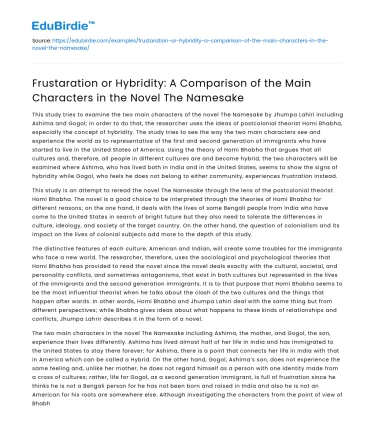This study tries to examine the two main characters of the novel The Namesake by Jhumpa Lahiri including Ashima and Gogol; in order to do that, the researcher uses the ideas of postcolonial theorist Homi Bhabha, especially the concept of hybridity. The study tries to see the way the two main characters see and experience the world as to representative of the first and second generation of immigrants who have started to live in the United States of America. Using the theory of Homi Bhabha that argues that all cultures and, therefore, all people in different cultures are and become hybrid, the two characters will be examined where Ashima, who has lived both in India and in the United States, seems to show the signs of hybridity while Gogol, who feels he does not belong to either community, experiences frustration instead.
This study is an attempt to reread the novel The Namesake through the lens of the postcolonial theorist Homi Bhabha. The novel is a good choice to be interpreted through the theories of Homi Bhabha for different reasons; on the one hand, it deals with the lives of some Bengali people from India who have come to the United States in search of bright future but they also need to tolerate the differences in culture, ideology, and society of the target country. On the other hand, the question of colonialism and its impact on the lives of colonial subjects add more to the depth of this study.
Save your time!
We can take care of your essay
- Proper editing and formatting
- Free revision, title page, and bibliography
- Flexible prices and money-back guarantee
The distinctive features of each culture, American and Indian, will create some troubles for the immigrants who face a new world. The researcher, therefore, uses the sociological and psychological theories that Homi Bhabha has provided to read the novel since the novel deals exactly with the cultural, societal, and personality conflicts, and sometimes antagonisms, that exist in both cultures but represented in the lives of the immigrants and the second generation immigrants. It is to that purpose that Homi Bhabha seems to be the most influential theorist when he talks about the clash of the two cultures and the things that happen after wards. In other words, Homi Bhabha and Jhumpa Lahiri deal with the same thing but from different perspectives; while Bhabha gives ideas about what happens to these kinds of relationships and conflicts, Jhumpa Lahrir describes it in the form of a novel.
The two main characters in the novel The Namesake including Ashima, the mother, and Gogol, the son, experience their lives differently. Ashima has lived almost half of her life in India and has immigrated to the United States to stay there forever; for Ashima, there is a point that connects her life in India with that in America which can be called a Hybrid. On the other hand, Gogol, Ashima’s son, does not experience the same feeling and, unlike her mother, he does not regard himself as a person with one identity made from a cross of cultures; rather, life for Gogol, as a second generation immigrant, is full of frustration since he thinks he is not a Bengali person for he has not been born and raised in India and also he is not an American for his roots are somewhere else. Although investigating the characters from the point of view of Bhabha shows that both characters can develop hybrid identities, Ashima succeeds while Gogol rejects the transformation which leads to frustration.






 Stuck on your essay?
Stuck on your essay?

